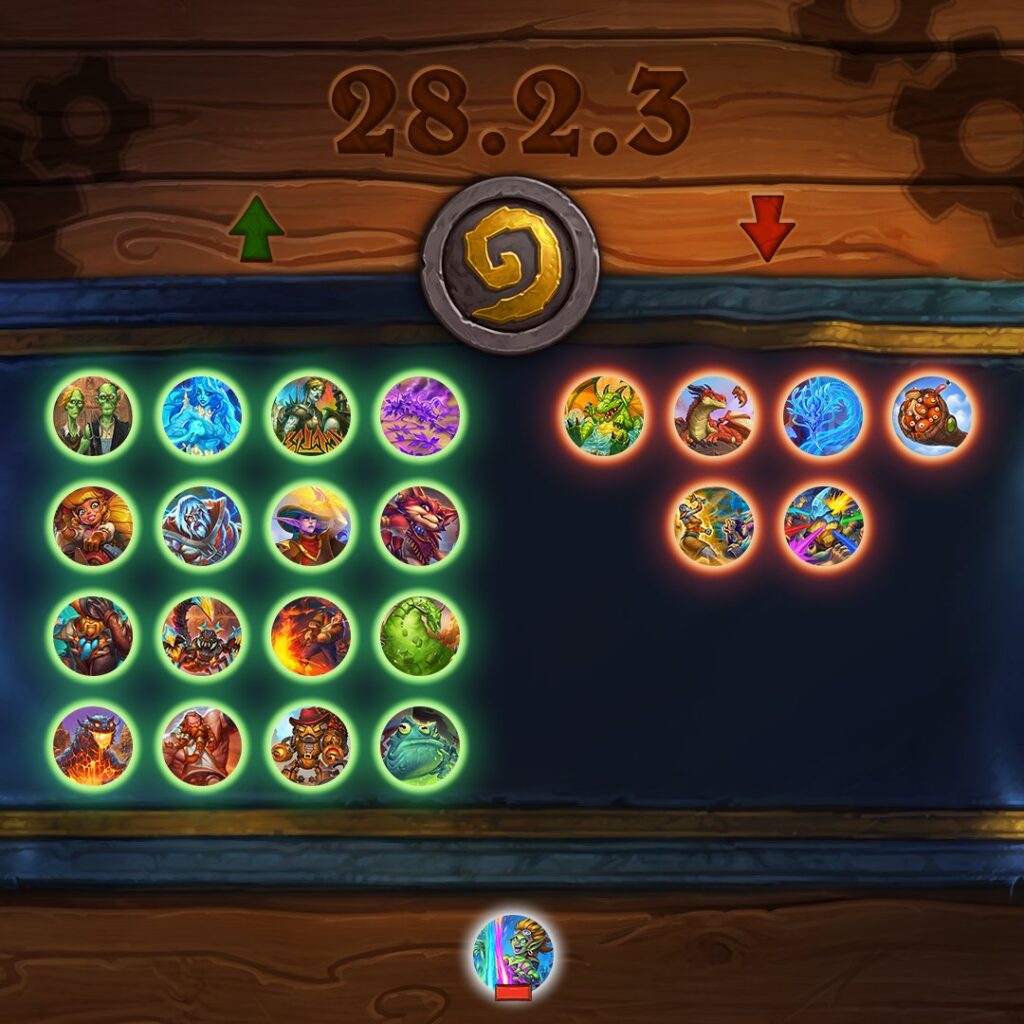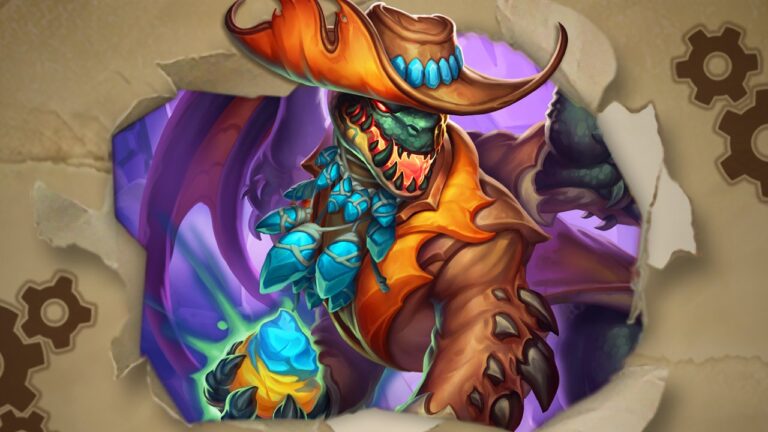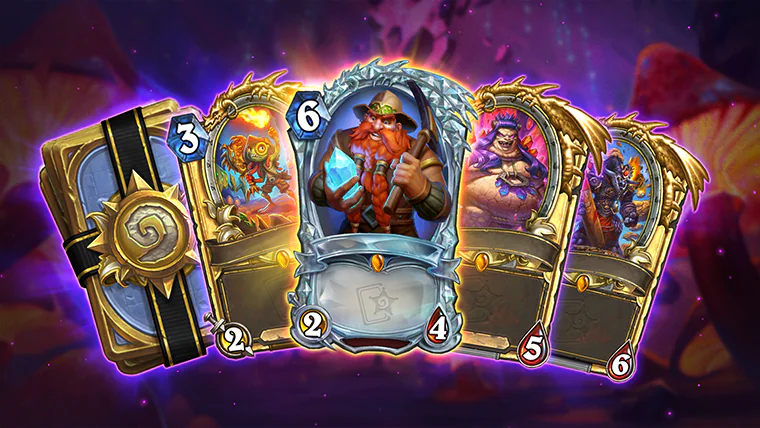Table of Contents [Hide]
Learn more about the Hearthstone Showdown in the Badlands (Patch 28.2.3) Standard metagame with our tailored Meta Tier List. Here, you'll find every deck for each class, tested and refined, to help you reach the Legend rank!
Hearthstone Standard Meta Overview

After a patch which aimed at reducing how strong Paladin was, a class which had three different archetypes with very similar concepts amongst the best in the game, the Hearthstone metagame feels a little more open lately. The road to legend remains dominated primarily but proactive, tempo oriented decks, as Treant Druid took over Paladin, but the Aggro build remains very solid nonetheless. Also, both classes have other builds well positioned as well, with Dragon Druid and Earthen Paladin, both stronger if you see a lot of defensive decks, looking to run you out of resources.
The most interesting part of the metagame concerns Tier 2 decks, with seven classes, and a lot of different synergies being featured. Most of them are building towards tempo, and trying to control the board to limit what the opponent is able to develop, but the key element is the engine of all those decks which are totally different.
Atop Tier 2 are Highlander Hunter and Naga Priest, two decks with the ability to deal a lot of damage out of nowhere if you give them a little too much room to play with. Hunter will be particularly effective against slow to develop archetypes, particularly if they don't have a lot of healing at their disposal. While Naga Priest on the other end, could be considered a midrange killer, as the deck will punish any build unable to deal with a big minion. Druid, in particular, is kept in check by this deck.
Behind them is a trio of control oriented decks with Highlander Shaman, Plague Death Knight and Rainbow Mage, all three based around stopping the opponent's momentum, and taking over as the game progresses. Shaman could be regarded as the control deck of the metagame, looking to slowly take over the game while the opponent cannot close the game and runs out of cards to pressure with. Death knight is the counter to the Highlander synergy through the Plagues you shuffle in the opponent decks. Last, Mage is more of the all-around reactive build with an OTK to close out the game, but the nerf to Inquisitive Creation has hurt the deck's momentum earlier in the month.
Closing Tier 2 are Rogue and Warrior, both classes rocking decks with great highs but devastating lows. Then, depending on the quality of your draw, you might be playing one of the best decks in the game, or one struggling to do anything for the first four turns. If you enjoy combo, or very synergistic builds, however, you should have a blast piloting these two archetypes.
Amongst the struggling classes, we have Demon Hunter and Warlock, which are mixing aggressive and high synergy concepts, but fail to impose their will on most opponents. Indeed, whenever they fall behind early in the match, they have to spend their damage into the opponent's board, which limits their ability to close out the match afterwards. They aren't necessarily far behind the other nine, which is a great sign for the overall balance of the Hearthstone metagame right now, but consistency seems to be the key to be considered a great deck right now.
With that crucial requirement in mind, it seems logic to see aggressive, low curve decks dominate soon after the patch, as they are much more likely to get what they need early in the match. Once in a dominant position, they put the responsibility on their opponent to find a way out of being bullied by a flurry of Treants in Druid, or divine shield units in Paladin. However, if any of the decks in Tier 2 manages to stop these two in their tracks early in the match, they can then impose their rhythm, and typically out value their aggressive opponent quite easily. Then, it feels like the difference between a Tier 1 and Tier 2 deck is mostly based on being reliable over large sample sizes of games.
Overall, it seems like most classes have a shot in the current environment, but all of them need to work towards quickly establishing themselves, or preventing the opponent from doing so. Then, once in control of initiative, there will be many more opportunities to leverage your synergies and force your opponent to play around what you could do, instead of the other way around. This is particularly important considering there aren't any specific tech card to edge against a variety of match ups so far, as the diversity of archetypes reduces the impact of these cards. As such, strong fundamentals are your best ally in order to perform in Hearthstone right now.
Best Hearthstone Deck for Every Class - Showdown in the Badlands - Patch 28.2.3
| Tier | Deck Archetype | Deck Code |
| Tier 1 | Treant Druid | AAECAZICArXjBKyeBg7XnwSuwASozgSB1ASy3QSxmAXsowX93wXO5AWw+gXZ/wW1mgbOnAbYnAYAAA== |
| Tier 1 | Aggro Paladin | AAECAZ8FBIbiBJT1BY3+BeOOBg3JoATavQS/4gTM4gSBlgXBxAXKxAWZjga8jwaOlQb1lQaqlga1ngYAAA== |
| Tier 2 | Highlander Hunter | AAECAR8e5bAE4qQFhY4GyPYF5soFqqQF5PUF0vgFsJ4G3+0Fzo4G1I4G1/kFj+QF57kE0/gF4Z8E8/IF6soFsJMFrqQFg8gEr6gG9qMGgJ8GkIMG6ukDre0F2IEGy44GAAAA |
| Tier 2 | Naga Priest | AAECAa0GBImyBPrbBM/2BaSdBg2i6AOIsgSktgSntgSGgwXdpAWVqgXIxgW7xwWi6QWFjgbGnAa4ngYAAA== |
| Tier 2 | Highlander Shaman | AAECAaoIHv2fBP6fBOWwBOC1BJa3BMbOBKrZBLbZBOnZBJnbBOKkBf3EBb7QBcTQBeXkBfboBa3tBc3uBfTyBY31Bcr4Bf74BYf7BZCDBvmMBqmVBuyVBqudBq2dBq+oBgAAAQPp2QT9xAWH+wX9xAXNngb9xAUAAA== |
| Tier 2 | Plague Death Knight | AAECAfHhBAak7wTipAXm5AWT+wXt/wX/lwYMopkF9fcFgvgF8vgFu/kF+PkF6/8FyoMG0IMG9YwG85EGlrcEAAA= |
| Tier 2 | Rainbow Mage | AAECAf0EBOv0BdH4BZiXBvKbBg3b3gSqmAWrmAWAwgXs9gXe+AW//gXY/gWk/wXxgAaFjgaDlQayngYAAA== |
| Tier 2 | Jackpot Tempo Rogue | AAECAZvDAwjYtgTbuQTMoAXooAXipAXHlAaOlgbkmAYL9p8E958E1bYE9d0E+fEE3aAF36AF4KAF38MFkIMG054GAAA= |
| Tier 2 | Enrage Warrior | AAECAQcEi6AEgdwEiN8Eud0FDZzUBLzbBP/bBL7iBImDBc2SBY+VBaCZBZGjBfTyBZf7BaT7BYqUBgAA |
| Tier 3 | Aggro Demon Hunter | AAECAea5AwKkkgX3wwUOtKAEiLIEmLoE+b8EpeIElaoF2dAF5OQF4fgFxfkFkIMGhpAGjZAGnJoGAAA= |
| Tier 3 | Sludge Warlock | AAECAf0GBJvkBICeBoSeBv/hBA3HwgXIwgXdwgXagAaVlwaWlwaXlwaYlwbXogb3owamqAaFjgbmxQUAAA== |
Impactful, Second Best Decks - Showdown in the Badlands - Patch 28.2.3
| Tier | Deck Archetype | Code |
| Tier 2 | Earthen Paladin | AAECAZ8FAov+BY3+BQ7JoATavQSgmQXBxAXu6QWK/gXCggaFjgaZjgbjjga8jwaOlQb1lQa1ngYAAA== |
| Tier 2 | Arcane Hunter | AAECAbv5AwSXoASGyQSwkgXX+QUNqp8EwNMEp5AFmpIFqpIFqZMFqqQF8/IFyvYFkIMGhY4G65gGwZwGAAA= |
| Tier 2 | Mech Rogue | AAECAaIHBti2BOy6BL/OBLb2Ber6BfajBgz3nwThtQT13QShkwXZ0AXV9gW/9wWm+AXm+gWh/AXn/QW5/gUAAA== |
| Tier 2 | Dragon Druid | AAECAZICBLCKBLWKBOKkBcGVBg2unwSQtQSuwASywQSjkwX93wWn+gW7lQa8lQa9lQbXnAbYnAbanAYAAA== |
| Tier 2 | Highlander Blood Death Knight | AAECAfHhBCjlsASWtwS42QT04wT94wSJ5ASU5ASJ5gSx5gSP7QSX7wSE9gSH9gSy9wSz9wS2+gSrgAWogQWimQXUoQXipAX9xAXGxwXgyAX0yAWP5AWt7QWt9QX++AXt/wXYgQaQgwaugwaUlQaplQbkmAbNngbPngbXogavqAYAAAEDieQE/cQFtvoE/cQFq4AF/cQFAAA= |
| Tier 2 | Control Warrior | AAECAQcEpfYF2IEGhYIGwpEGDY7UBJDUBOrQBevQBezQBbT4BbX4BZD7BaH7BaT7BcqDBpKOBouUBgAA |
Disclaimer and Tier Explanations
There are a variety of ways to be informed about the Hearthstone metagame, a logical trait of a 10 years old game. In order to craft this tier list, den, a veteran coach and competitor on Hearthstone, has combined the data available on the popular deck trackers, the opinion of top ranked players about the dominant decks, and its own expertise plus tested of the archetypes on this list.
This list should represent the Diamond and Legend ranks pretty well, with the very top of the ladder being excluded. Indeed, once you reach the top of the Legend rank, the game changes and focuses much more on combo and explosive patterns, which require a lot of time to master completely. Then, you will typically see different decks perform at those ranks, or archetypes be built to specifically match the environment of these ranks.
As for the ranks before Diamond, those tend to be more about game fundamentals rather than precise archetypes. One should be able to reach Diamond with any deck on the rankings, as long as they understand the basics of crafting a game plan, seizing initiative, and building momentum to pressure the opponent.
The lists aren't set in stone, particularly the reactive decks, which need to be tailored to your most popular opponent. Often, a proactive deck will focus on its own strengths, leading to a decklist which isn't very flexible once we found the right balance. On the other end, a reactive deck is designed to answer other decks, or trends of the metagame, meaning they have to be adapted to your own environment.
Tier 1: Decks with a stellar win rate, around or above the 60% mark, and more than a thousand games with that win rate. Either their match-up spread is great in the current environment, or they rely on game mechanics which are simple enough to suit a large variety of player, boosting their performance over large sample sizes.
Particularly before the Legend Rank, these decks should be ideal to climb steadily.
Tier 2: Solid decks in the current metagame, with a win rate north of 53% and the ability to compete against a large variety of decks. Typically, these decks will require a little more knowledge of the game fundamentals, or the current environment in order to put up the same win rate as a Tier 1 deck.
Tier 3: Decks with something holding them back currently, either their sheer power compared to other decks, or a bad match-up being too unpopular.
Particularly on the road to the Legend rank, decks need to be able to fight for initiative, and stop an opponent able to snowball in the early to mid-game. Unfortunately, some classes simply don't have the tools for that.
Conclusion
For any question about the rankings, or a deck in particular, feel free to reach out on Twitter. I mostly share Marvel Snap decks lately, but I still love and play Hearthstone daily, I promise.
Good game everyone!


